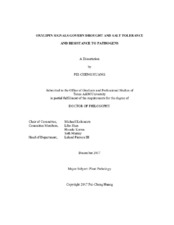| dc.description.abstract | Lipid signals derived from lipoxygenases (LOX), called oxylipins, emerge as pivotal mediators in responses to environmental constraints including biotic and abiotic stresses. Anthracnose leaf blight and stalk rot caused by Colletotrichum graminicola are major diseases threatening corn production; drought and salinity severely devastate crop yield. The involvement of specific LOXs in defense responses to C. graminicola and tolerance to drought and salinity remain largely unknown. The first objective of this study was to elucidate the functions of dual-specific LOXs in defense against C. graminicola. The second objective aimed to test the hypothesis that LOXs regulate drought and salt stress tolerance in maize.
Transposon-insertional mutants and near-isogenic wild type of several LOXs, 12-oxophytodienoic reductase (OPR), and ACC synthase (ACS) were utilized to investigate the oxylipin-mediated responses to C. graminicola, drought, and salinity.
Results showed recombinant ZmLOX1 protein imparts both 13- and 9-LOX activities, a unique feature for plant LOX. Defense phytohormones, mechanical wounding, and Z-3-hexenal treatment significantly up-regulated ZmLOX1 and ZmLOX2 expression, suggesting roles in various stress responses. Disruption of these genes does not impair wound-induced JA biosynthesis. Genetic evidence is provided that disruption of ZmLOX1 or ZmLOX2 caused a significant decrease in resistance to C. graminicola in leaves that associated with lower benzoic acid (BA) and salicylic acid (SA) accumulation. By contrast, lox1-3 and lox2-1 mutants accumulated significantly higher
level of SA, but lower 10-oxo-11-phytoenoic acid (10-OPEA) in stalks upon C. graminicola infection, resulting in increased resistance. These findings have shed light on understanding that these rare dual specific LOXs play a role in defense against pathogens.
In this study, evidence is provided that ZmLOX2 is required for drought tolerance via regulating transpirational water loss, while ZmLOX4 promoted drought sensitivity. Metabolite profiling and RNA sequencing results suggest that oxylipins regulate maize drought tolerance by mediating JA biosynthesis pathway. Supporting this notion, a JA-deficient mutant opr7-5 opr8-2 displayed dramatic reduction in stomata aperture and transpirational water loss, indicating that JA serves to open stomata. Increased ET production of opr7-5 opr8-2 under drought stress is in agreement with higher transpiration of ET-deficient acs2 acs6 mutant, suggesting ET enhances stomatal closure. Excessive amounts of SA and 10-OPEA accumulation in lox1-3 correlated with increased sensitivity to salt stress. Collectively, these data suggest that oxylipin signals govern drought level of SA, but lower 10-oxo-11-phytoenoic acid (10-OPEA) in stalks upon C. graminicola infection, resulting in increased resistance. These findings have shed light on understanding that these rare dual specific LOXs play a role in defense against pathogens.
In this study, evidence is provided that ZmLOX2 is required for drought tolerance via regulating transpirational water loss, while ZmLOX4 promoted drought sensitivity. Metabolite profiling and RNA sequencing results suggest that oxylipins regulate maize drought tolerance by mediating JA biosynthesis pathway. Supporting this notion, a JA-deficient mutant opr7-5 opr8-2 displayed dramatic reduction in stomata aperture and transpirational water loss, indicating that JA serves to open stomata. Increased ET production of opr7-5 opr8-2 under drought stress is in agreement with higher transpiration of ET-deficient acs2 acs6 mutant, suggesting ET enhances stomatal closure. Excessive amounts of SA and 10-OPEA accumulation in lox1-3 correlated with increased sensitivity to salt stress. Collectively, these data suggest that oxylipin signals govern drought and salt tolerance and resistance to pathogens. | en |


